The adage, “If it walks like a duck, and quacks like a duck,” doesn’t address the different types of ducks out there.
For example, some nest in the trees, others on dry ground. Some dive, while others just swim upside down with their tails in the air.
There are over a hundred types of ducks worldwide, but all species fall into three main classifications: dabbling, diving, and perching.
Diving ducks dive, dabbling ducks put their bums in the air and seek food close to the water’s surface, and perching ducks enjoy wet woodlands and may nest in a tree.
In short, duck types vary in size, habitat, and behavior. In this article, we’ll explain more about the three main classifications and take a dabble into some of the specific types of ducks and their traits.

What Is A Duck?
Fun fact: not all ducks quack, but wood frogs do. Nor can you identify a duck by a waddle since geese do it too.
Instead, these species of waterfowl in the Anatidae family (ducks) are identified by their tightly connected feathers, an “oily” waterproof coating, compact bodies, short necks, webbed feet, and flat bills that feature a “nail.” They are some of the types of birds that are found in habitats with plenty of water.
Ducks also boast a “countercurrent exchange system” to prevent their feet from freezing. It is a unique network of blood vessels found in many animals, characterized by how the veins and arteries are arranged beside each other.
It keeps their feet from freezing and minimizes the duck’s heat loss by ensuring the blood returning from their feet to the body is warm.
Duck Types
There are many different types of ducks, varying in plumage, size, habitat, and behavior.
For example, the smew duck looks like a small swan with a black beak and accents that like to nest in trees. There is also the surf scoter, which looks like a puffin and a seagull had a baby.
An estimated 34.2 million ducks exist worldwide, on every continent except Antarctica. Consequently, most duck types are not in danger.
But there are exceptions, such as the Madagascar pochard, which in the late 90s was believed to be extinct. Thankfully, in 2006 more were discovered, but their numbers are still estimated to be less than a hundred.
Yet all the types of ducks on the planet are grouped into three categories: diving, dabbling, and perching.
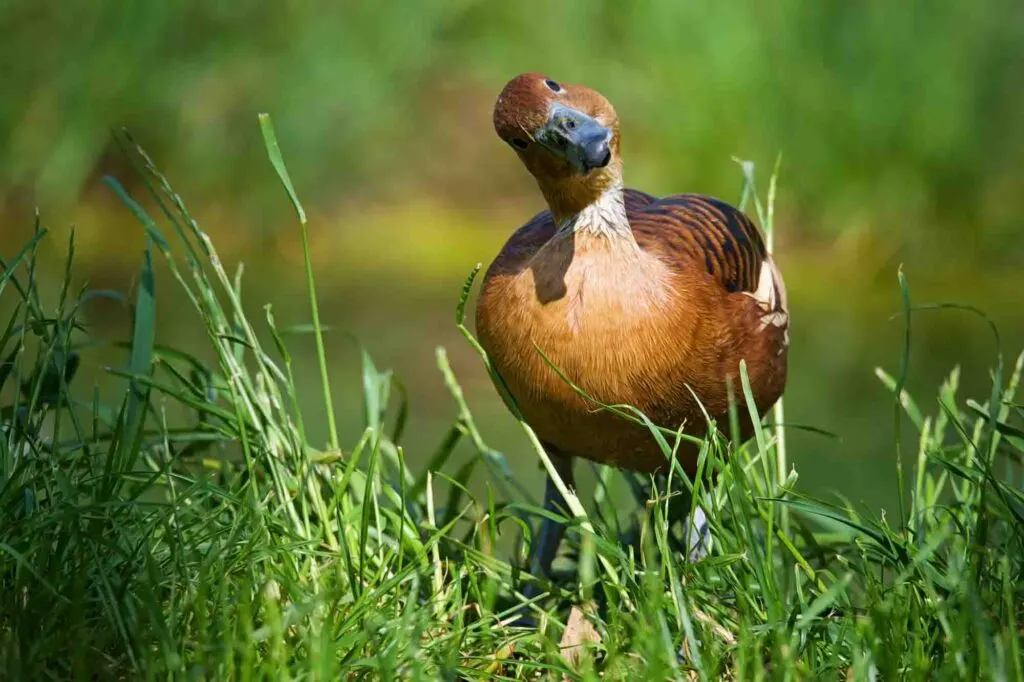
Diving Duck
Diving ducks are known for diving, which enables them to feed on fish and crustaceans.
Some have been recorded going over 40 feet in depth. These types of ducks can hold their breath for up to a minute, although most only stay under for 10-30 seconds.
They sit lower in the water than a dabbling duck, thanks to their neat trick of squeezing their feathers tight, expelling the air.
Their bodies are larger than dabbling ducks, including their feet which allow them to navigate the water better.
However, their bigger size and feet make them more awkward on land. Their wings are relatively short in relation to their size.
Consequently, these types of ducks generally can’t take off vertically but must beat their wings hard and run over the water like a plane readying for take-off.
Their landing also mimics a plane, the water acting as their runway.
Dabbling Duck
Dabbling ducks, sometimes called puddle ducks, are known for sticking their bums in the air when searching for food in the water.
While some dabblers will dive when fleeing predators, these types of ducks are not known to submerge themselves fully.
Instead, they float high on the water and have smaller feet than their diving cousins. In addition, their legs are placed in a more forward position to divers.
Dabbling ducks eat food near the water’s surface, such as larvae, insects, and vegetation.
They are often found in marshes and shallow bodies of water. These types of ducks are known for their vertical flight from the water rather than taking off like an airplane with webbed feet.
Perching Duck
Perching ducks are generally found in wet woodlands. They are known for making their nests in the trees.
Their toes boast long claws that enable them to perch in the branches easily. Their short yet broad wings are adapted for maneuvering swiftly amongst dense forests.
However, despite their penchant for trees, their mating and food habits are much like the dabbling duck types.
Thus, these types of ducks remain dependent on water. One of the most well-known perching ducks is the Mandarin.
19 Different Types of Ducks
Let’s take a look at the different types of ducks divided by categories.
Diving Ducks
1. Red-Breasted Merganser

The red-breasted merganser (Mergus serrator) is a Northern American diving duck known for its shaggy punk feather-do and serrated bill, giving it the nickname “sawbill.”
They will hang out in fresh and salt water wetlands, including lakes, rivers, estuaries, and bays. They gobble 15-20 fish daily, which requires 250-300 dives.
Being one of the fastest birds on Earth, the red-breasted merganser can reach a flying speed of 81 miles per hour.
Red-breasted mergansers are 20.1-25.2 inches long, 28.2-47.6 oz, and have a wingspan of 26-29.1 inches.
The drakes have dark green heads, a white neck band, and a speckled reddish-tan chest. The hens have a brown head and a speckled brown body.
The drakes give off a raspy, two-beat sneeze, and the hens give off a muted, croaking quack.
2. Ring-Necked Duck
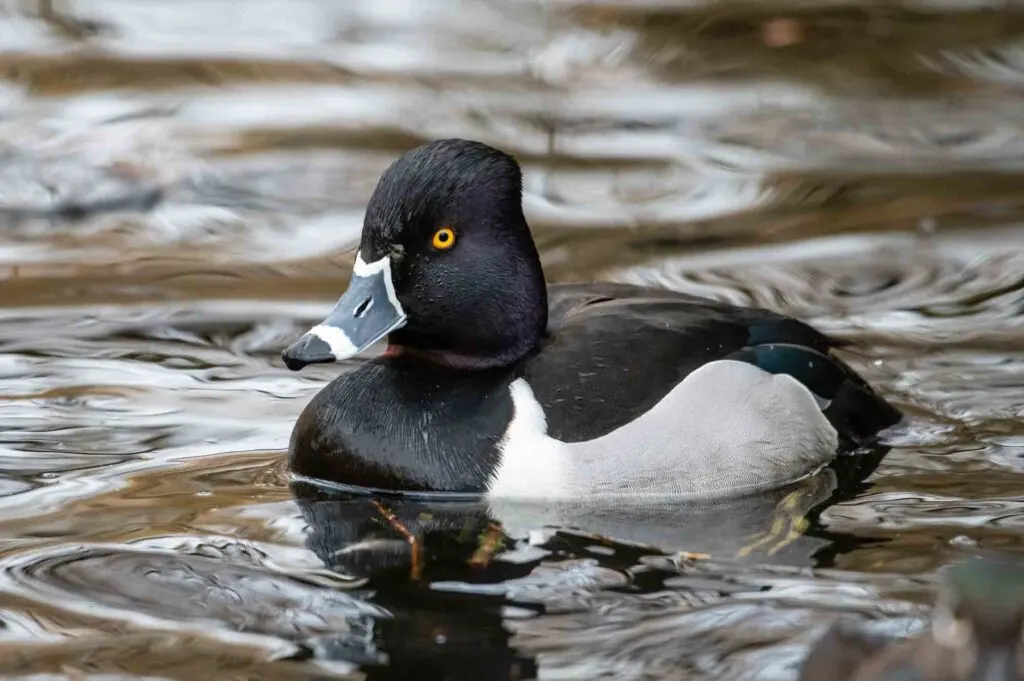
The ring-necked duck (Aythya collaris) is a freshwater medium-sized duck in North America. They are one of the few diving ducks that can take off vertically, like a dabbling duck.
These species of duck are serially monogamous, the pair remaining exclusive for a single breeding season, where the hen will lay 8-10 buff or olive-colored eggs.
The adults have compact bodies, long neck, and peaked crown that descends into sloping forehead. They weigh 17.3-32.1 ounces, are 15.3-19.1 inches long, and have a wingspan of 24.4-24.8 inches.
The drakes have a black head and body, a white chest, and a white framed bill. The hens have a dark brown head, paler brown pattered body, and some white stripe before the bill.
The ring-necked duck is often found hanging out with dabblers in shallower freshwater, such as ponds, marshes, and flooded farm fields. Although fish is their primary food source, they also eat vegetation.
Did you know? Wild ducks can live between 5 and 10 years, while domestic ducks may live 10 to 15 years when well cared for.
3. Ruddy Duck
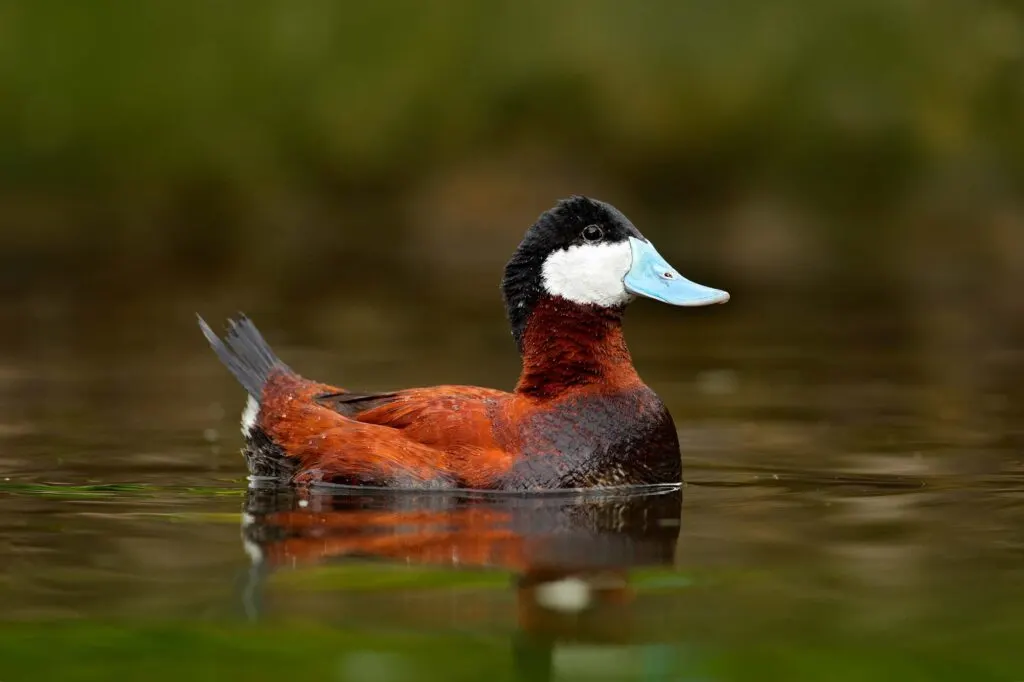
The ruddy duck (Oxyura jamaicensis) is a North American stiff-tailed diving duck species.
The drakes are known for their compacted chestnut body, white cheeks, and blue bill, which somehow reminds us of the blue-footed bobby’s feet (one of the weirdest birds ever!).
The hens are brown and have a whitish head with a brown stripe. The adults weigh 10.6-30 ounces, are 13.8-16.9 inches long, and have a 22.1-24.4 inch wingspan.
The drakes are mostly silent except in courtship, where they release a sound similar to a belch.
The hens have a nasal call used to keep track of their chicks and a high-pitched noise to ward off unwanted male attention.
Ruddy ducks favor the Prairie Pothole region and like lakes and ponds. They are shallow divers and feed on aquatic plants, insects, larvae, seeds, and roots.
4. Harlequin Duck
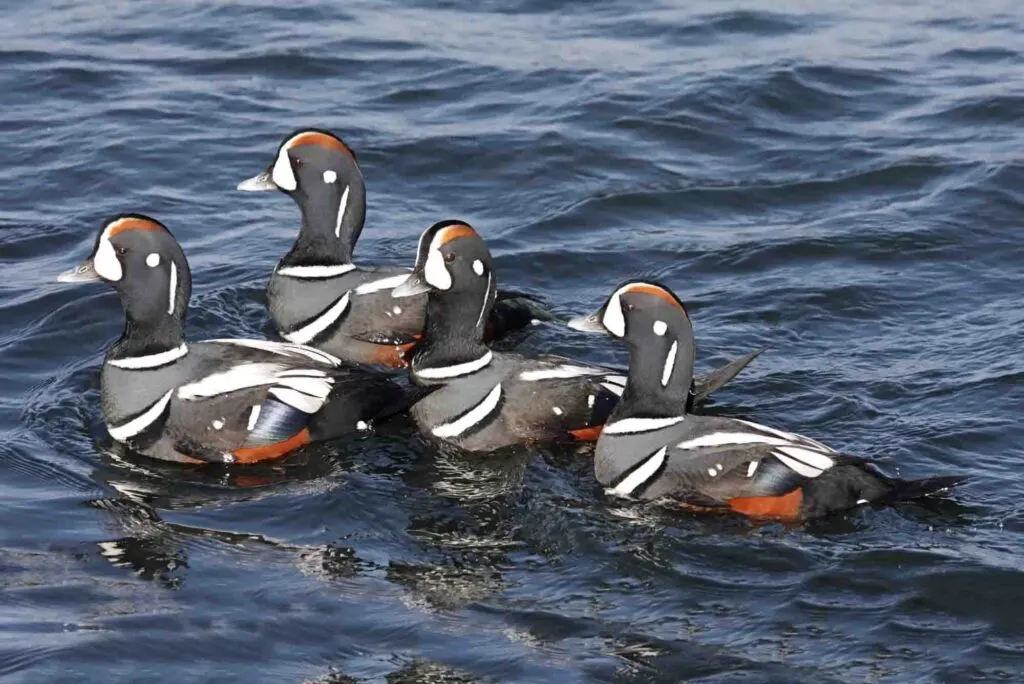
Harlequin ducks (Histrionicus histrionicus) are diving ducks fond of fast-moving water. They are found in North America, Iceland, eastern Russia, and Greenland, one of the largest islands in the world.
In summer, they hang out near cold, rushing streams, building their ground nests nearby. In the winter, they favor exposed, rocky coastlines and take on rough water. Consequently, broken bones are common.
Harlequin ducks weigh 17.3-26.8 ounces, are 13.4-18.1 inches long, and have a 22.1-26-inch wingspan.
The drakes have a dark slate blue head, lighter slate blue body, chestnut sides, and are slashed with white.
The hens are gray-brown, with white markings near the eyes and bill. They squeak rather than quack, hence the nickname sea mouse.
The shallow divers eat mussels, periwinkles, insects, and some plants. Occasionally they’ll indulge in crabs, tiny fish, and marine worms.
5. Canvasback

The canvasback (Aythya valisineria) is North America’s largest diving duck. They like deep water, such as lakes, bays, ponds, and marshes.
Their unique nests are typically bulky baskets made to float on shallow water. They prefer eating the leaves and roots of plants. However, they will munch on some mollusks, insects, and fish.
The adults weigh 30.4-56 ounces, are 18.9-22.1 inches long, and have a 31.-35-inch wingspan.
The drakes have eye-catching cinnamon-red heads and necks and white bodies set off with black chests, rear, and bills. Their eyes are red. The hens are pale brown, with a dark beak and eyes.
The drakes coo while the hens give a deep krr. The nonbreeding canvasbacks give a wheezing call.
6. Black Scoter
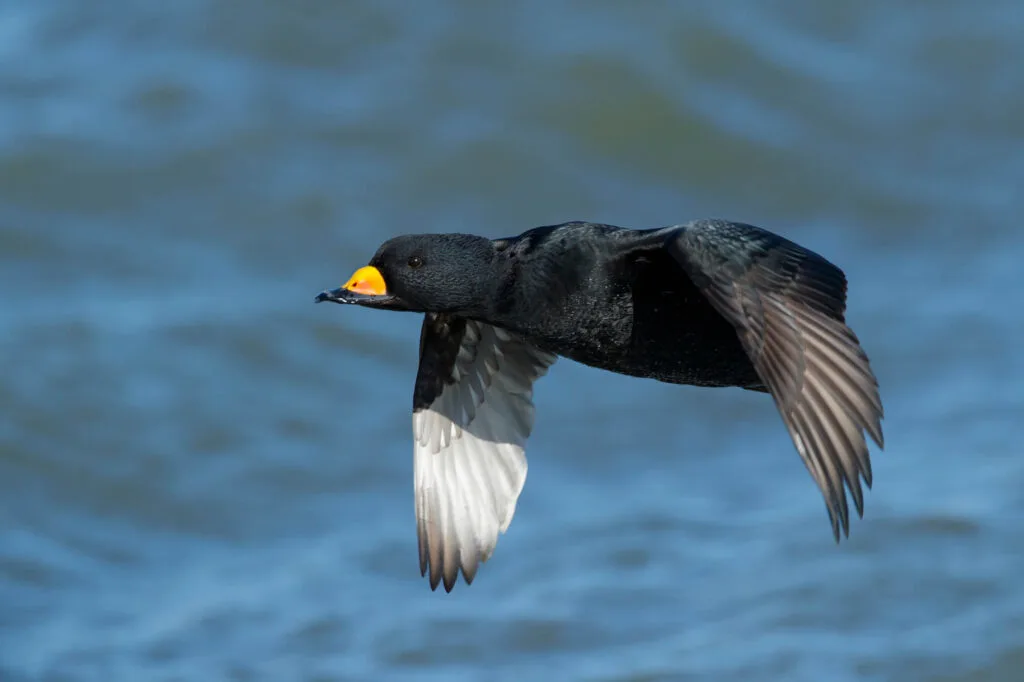
The black scoter (Melanitta americana) is a diving duck species found in Labrador, Newfoundland, and Siberia near the Bering Straits.
They’ve been known to winter further south on the Pacific Northwest, as far down as San Francisco.
Adult black scoters weigh 30.4-38.8 ounces, are 16.9-19.3 inches long, and have a 27.6-28.4 inch wingspan.
The drakes are glossy black ducks with a prominent orange bulb on the base of their bill. The hens are brown, with pale cheeks, and are dark at the tops of their heads.
Drakes will give a low, descending whistle during mating that the hens will echo. They may also give a tuck-tuck trill.
Black scoters are marine birds but will come inland during bad weather, hanging out in lakes and large rivers.
During the breeding season, they seek out boreal forest lakes. They feed primarily on shellfish found in the shallows.
7. Long-Tailed Duck
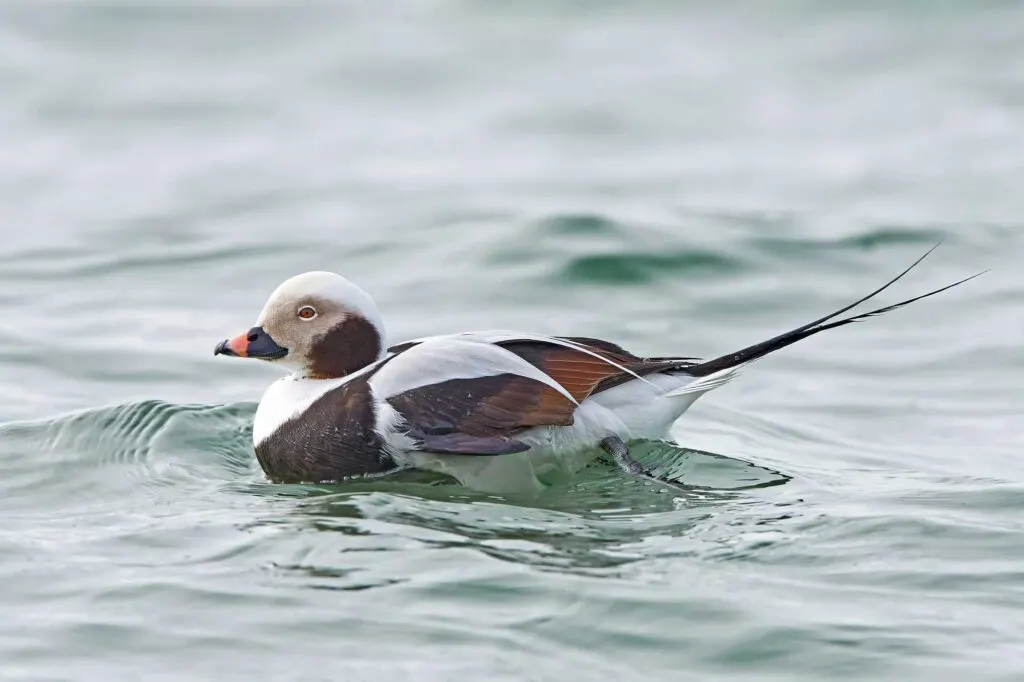
The long-tailed duck (Clanguia hyemalis) is an artic-coast diving duck. They hang out in the open ocean or large lakes.
They are superb divers, plunging as much as 200 feet deep. When forging for food, they may spend 3 to 4 times underwater as they do above.
They feed off crustaceans, mollusks, invertebrates, fish eggs, small fish, larvae, and insects. They tend to avoid land except when it is breeding season.
Adult long-tailed ducks weigh 22.9-38.8 ounces, are 15.8-18.5 inches long, and have a 27.9-28.4 inch wingspan.
Drakes sport two coats. In winter, they have a white head, a gray face, and a black patch on the neck, part of the chest, and back. In summer, their plumage reverts to the opposite.
Hens are primarily brown with white plumage on the face, brown crown, and brown cheek patch.
Their two-beat yodel has been described as being likened to hooting “Tom-Connolly.” They use it with great frequency.
8. Common Goldeneye
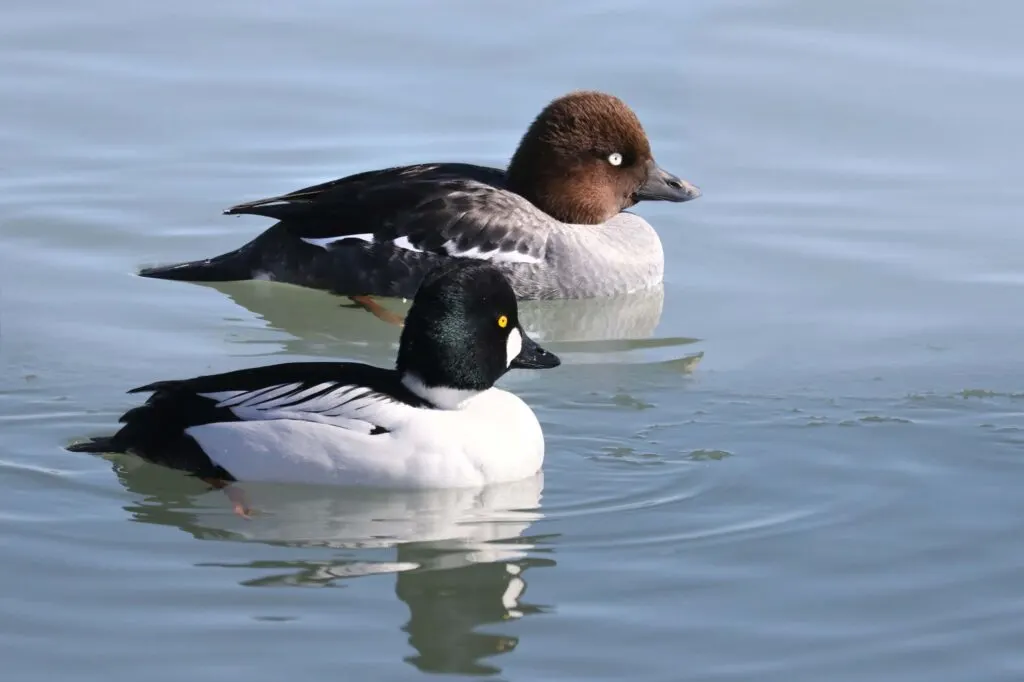
The common goldeneye (Bucephala clangula) is a North American perching duck that also dives.
These sea ducks nest in tree cavities in boreal forests and head to protected coastal waters for winter. They live off crustaceans, insects, mollusks, and some aquatic plants.
The adults weigh 21.2-45.9 ounces, are 15.8-20.1 inches long, and have a 30.3-32.7-inch wingspan.
The drakes have a dark, nearly black, green head, circular white cheek patch, and black and white bodies.
The hens have brown heads and gray bodies flecked with white. Both have golden eyes. Their tales are short and have streamlined bodies.
The common goldeneye is pretty silent. The drakes may faintly grunt during mating and the hens croak when disturbed. But during flight, their wings whistle.
Interestingly, not all hens raise their young. Instead, they’ll abandon the chicks for another hen to raise with her own.
Also, like the magpie, some hens will lay their eggs in other nests, even of ducks of a different breed.
9. White-Winged Scoter
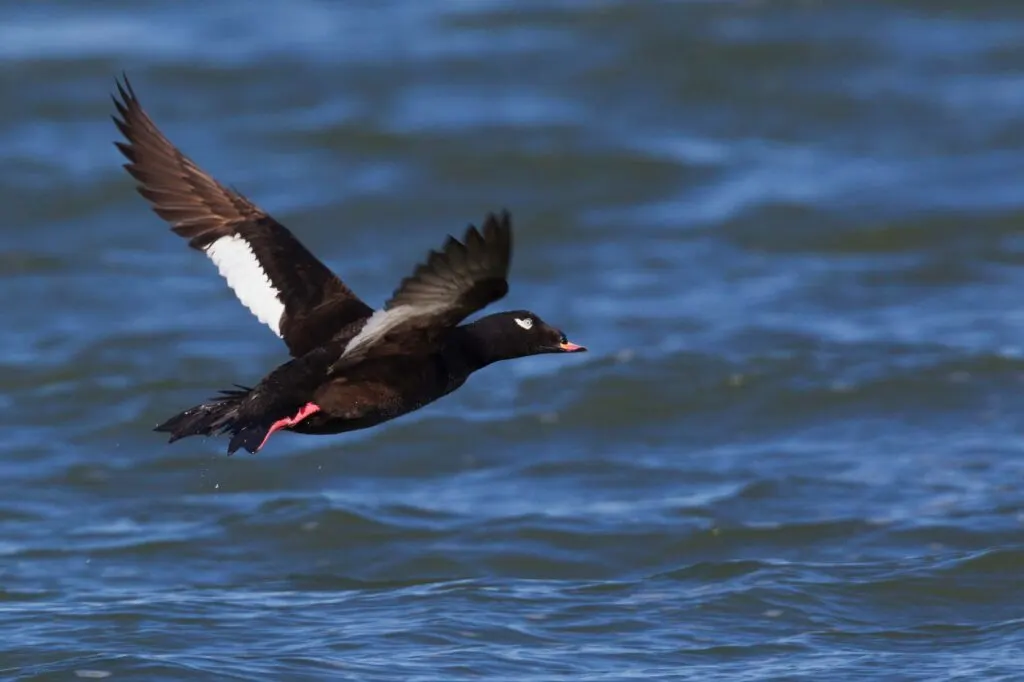
White-winged scoters (Melanitta degland) are coastal diving ducks capable of holding their breath for over a minute as they pry shellfish from rocks.
They are primarily found in North America, more specifically Canada, and will head inland during the breeding season, making ground nests near lakes, marshes, and ponds.
Adults weigh 33.5-63.5 ounces, are 18.9-22.8 in length, and have a 31.5-inch wingspan.
The drakes are a glossy back, with a white check mark extending out from the eye and white patches in the rear of the wings.
Their feet are dark orange, with a slightly paler bill. The hens are lighter black or brown, with white patches and a dark bill.
These sea ducks don’t quack. At sea, they rarely vocalize. However, during courtship, they emit a high-pitched whistle.
Hens will also produce a low kaak-kaak-kaak call if distressed. There is also a whistling noise made by their wings while in flight.
Dabbling Ducks
10. Northern Pintail
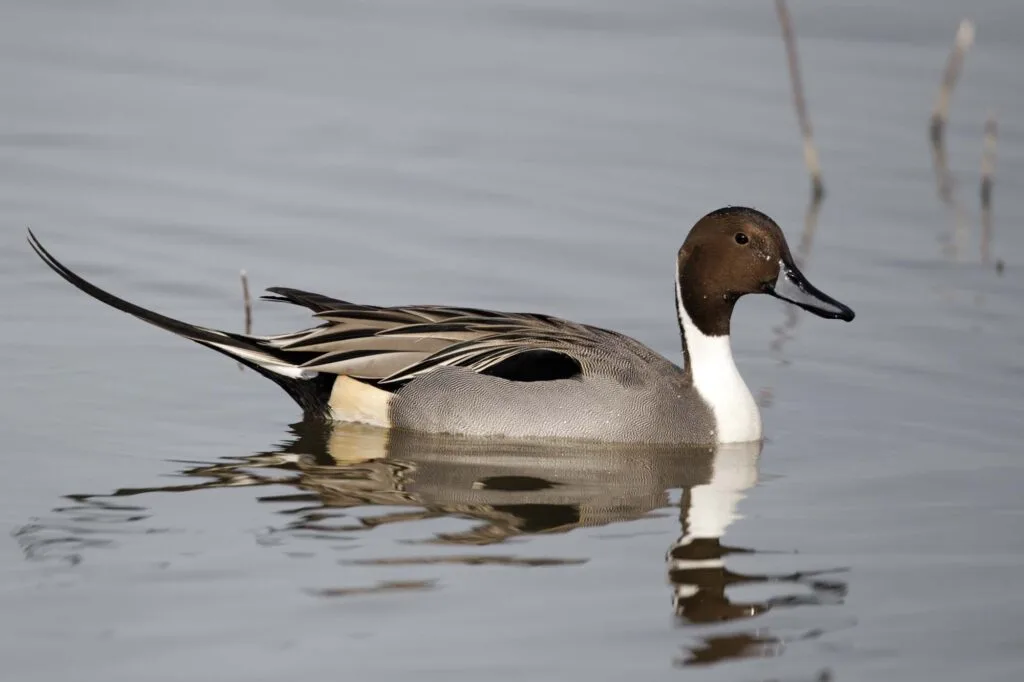
The Northern pintails (Anas acuta) is a dabbler in Northern America and Europe.
They are the ballerina of ducks, with elongated necks and slender bodies, and their 34-inch wingspan enables graceful flight.
The drakes (males) have a dark head and upper neck, a white chest, weigh 1-3 pounds, and are 23-30 inches long. Instead of a quack, they produce a trainlike whistle.
The hens (females) have a plain light brown head and patterned brown body, 1-2.5 pounds, and 20-25 inches long. Unlike the drakes, the hens quack.
Some flocks will live year around in part of the Northwest regions of the US. But most are migrating and will form mixed flocks.
These slender ducks spend spring and summer breeding in North America and the upper areas of Europe, laying 7-9 cream-colored eggs in a ground nest.
Then, when the weather cools, they migrate south, some as far as the equator.
They move fast, covering up to 48 miles in an hour. One Northern pintail was recorded flying 1,800 miles nonstop.
Northern pintails enjoy open areas with shallow water, such as wetlands, ponds, lakes, tidal marshes, or a flooded farmer’s field.
They feast on aquatic plants, seeds, leaves, grain, and roots. They’ll also eat minnows, insects, snails, and worms in lesser amounts.
Did you know? While most ducks can fly, there is a handful that is almost flightless.
11. Blue Duck
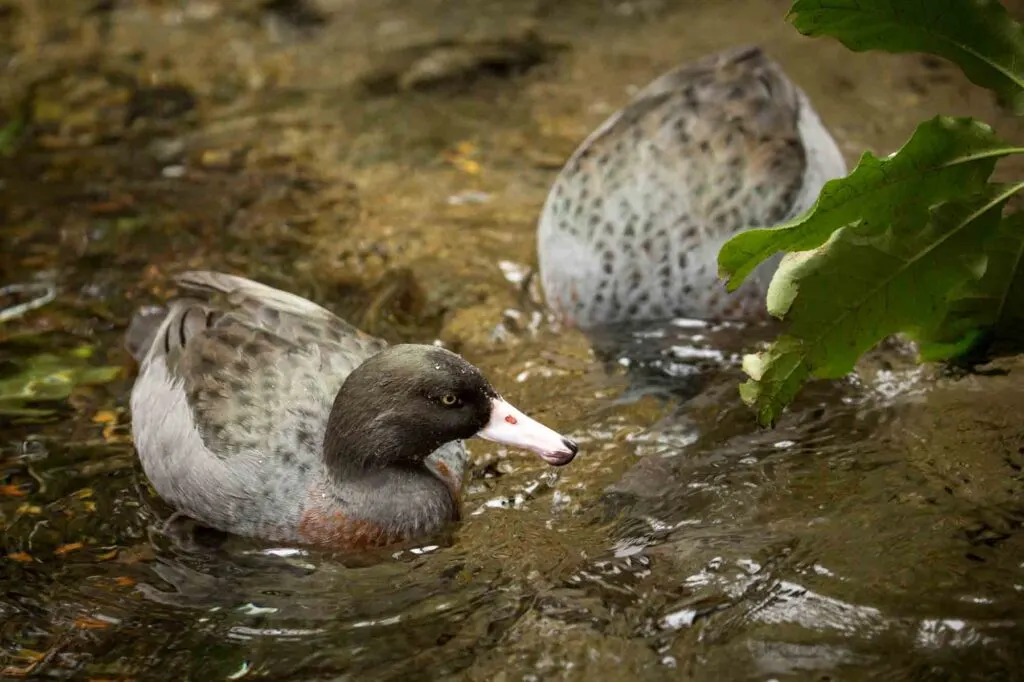
The blue duck (Hymenolaimus malacorhynchos), also known as the whio, is an endangered diving duck from New Zealand.
They prefer fast-flowing inland streams and nest on riverbanks, which has left them vulnerable to floods, feral cats, ferrets, and rats.
They only fly when they must, preferring to swim. Unusually for ducks, they are primarily carnivores, mainly feasting on aquatic insects.
The drakes weigh 29-34 ounces and average 21 inches long. The hens weigh slightly less, 24-31 ounces.
Unusually, the plumage is nearly the same, a dark-bluish gray body, chestnut chest, and pale bill with black markings.
Neither sex quacks. The drakes give a high-pitched whistle when defending territory, and the hens will growl when upset.
12. Mallard
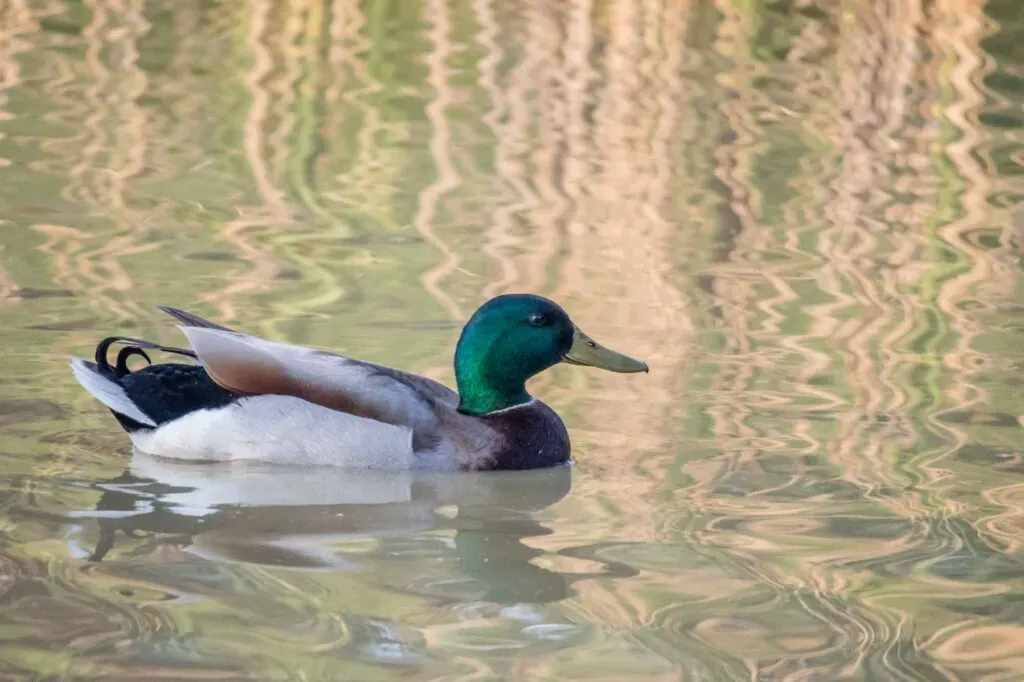
The mallard (Anas platyrhynchos) is one of the most common ducks to encounter in a park. The popular dabbler is also a favorite amongst hunters.
They are found across North America and Eurasia and have been controversially introduced worldwide, including South Africa, New Zealand, Australia, the Falkland Islands, and across South America.
The bulk of domesticated ducks can trace their lineage to the mallard, as the birds are not easily put off by humans.
Wild mallards have been known to make their homes on peoples’ properties should they have a marshy area or an attractive pond. They’ve also been known to swim in people’s pools for fun.
Adult mallards weigh 35.3-45.9 ounces, are 19.7-35.6 inches long, and have a 32.3-37.4 inch wing span.
The drakes are recognized by the emerald green plumage on their heads, classic yellow bill, bright orange feet, brown to gray body, black rear, and iridescent-blue to purple wing tips. The female mallards are far less flashy, with a brown pattered body.
Mallards are easygoing when it comes to food, eating a wide range of plants, roots, seeds, grains, insects, crustaceans, mollusks, tiny fish and frogs, tadpoles, and earthworms.
While they love bread, it isn’t good for them and can give them a condition called “angel wing.” Instead, tossing them lettuce, cabbage, non-citrus fruit, broccoli, or peas is better.
Read next: Animals That Start With M
13. Northern Shoveler

The northern shoveler (Spatula clypeats) is a ground-nesting dabbling duck. They are known for their distinctive “spoon” like a bill that they swish from side to side under the water’s surface filtering out seeds and invertebrates to munch.
They are found in shallow wetlands of North America, Europe, northern South America, the Caribbean, Southeast Asia, and the Caribbean.
The adult northern shovelers weigh 14.1-28.9 ounces, are 17.3-20.1 inches long, and have a wingspan of 27.2-33.1 inches.
The drakes have a beautiful iridescent green head, white body, cinnamon-red sides, and black back.
During courtship, they release a took-took sound. The hens are a plain, brown patterned plumage and quack.
14. Brazilian Teal Duck

The Brazilian teal duck (Amazonetta brasillensis) was initially classed as a perching duck but is now considered dabbling.
The South American ducks are primarily light brown. But the drakes have reddish-orange beaks and legs and iridescent green wing feathers that are visible when they fly.
The Brazilian teal duck weighs 12.3-16.9 ounces and is 13-15 inches long.
Only Brazilian duck chicks eat insects. The adults stick to seeds, roots, and fruit.
They prefer to hang out away from the coast, in areas of dense vegetation with plenty of freshwater areas to swim.
15. American Wigeon
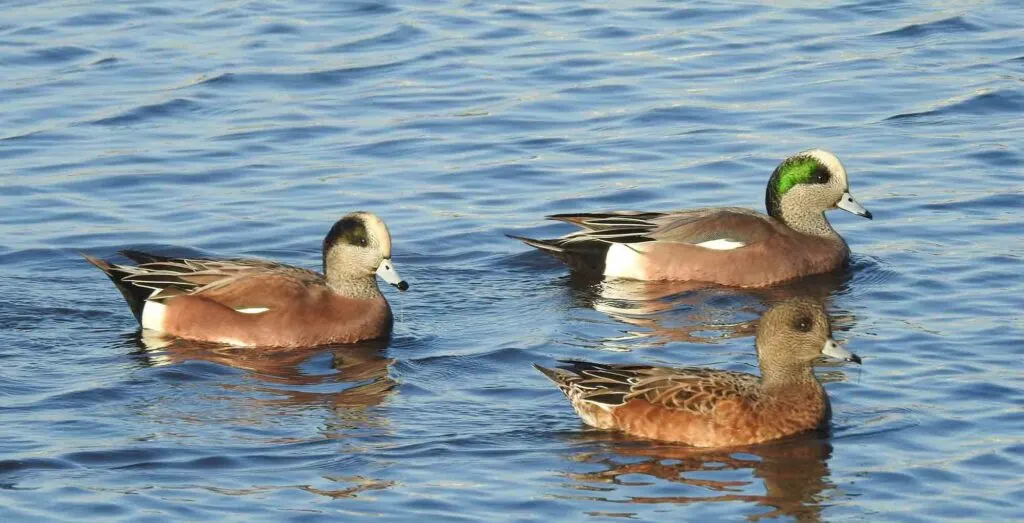
The American wigeon (Mareca americana) is a dabbler found in North and Central America and the top slight of South America.
They are found in lakes, slow-moving rivers, flooded fields, bays, estuaries, and marshes. Unlike most ducks, they live almost exclusively on plants.
The adults sport a short bill, rounded head, and compact body. They often swim with their necks tucked, making them appear neckless.
They weigh 19.1-46.9 ounces, are 16.5-23.2 inches long, and have a 33.1-inch wingspan.
The drakes spice up their speckled brown heads with mallard-green eye shadow that extends to the neck.
Their pale reddish-cinnamon contrasts with their white bum, black upper wings, and green patches in their lower.
The hens are brown with a golden eyeshadow. Both sexes sport pale blue bills with a black tip, like goth lipstick.
16. Cinnamon Teal
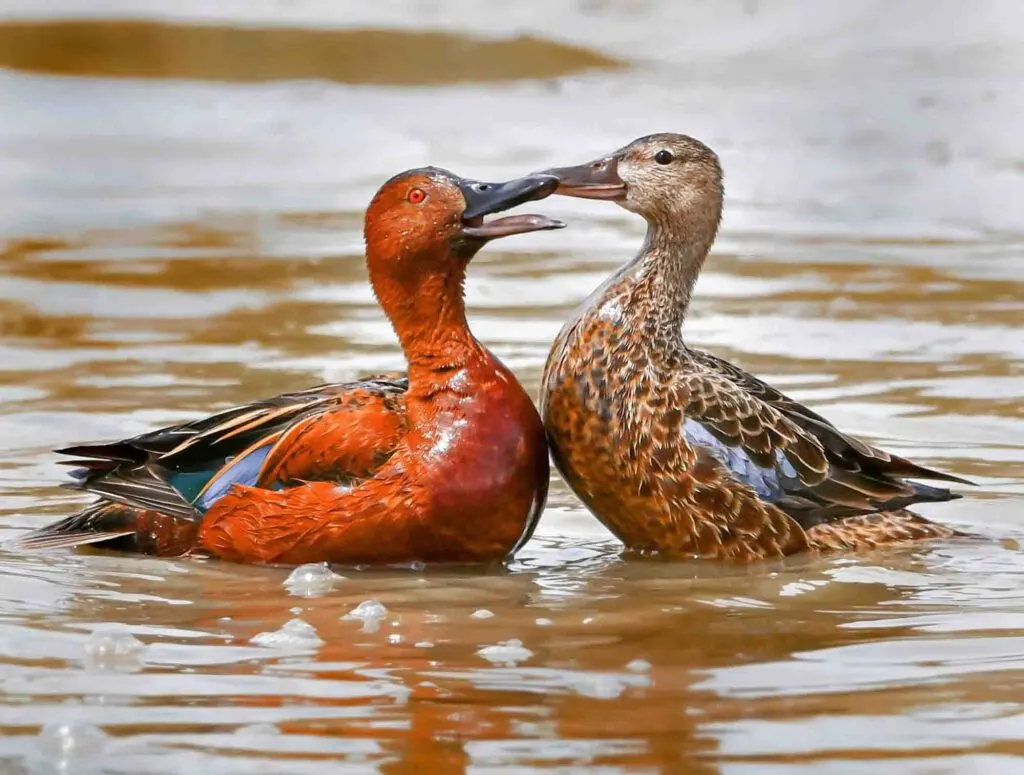
The cinnamon teal (Spatula cyanoptera) is a dabbling duck found in marshes and ponds across the western regions of North and South America.
They are serially monogamous, meaning their exclusive relationship only lasts a year.
Their nests are hidden in thick vegetation near the water, often requiring the parents to tunnel in. They mainly eat seeds and plants.
The drakes have rich cinnamon plumage with dark feathers on the back and take.
Similar to blue-winged teal females, the hens are lighter, with pattered bodies. These types of ducks are pretty small, only 12.6-18.2 oz, 11 inches long, and have a wing span of 25 inches.
The drakes make a chattering call while the hens quack.
Perching Ducks
17. Wood Duck

The wood duck (Aix sponsa) is a North American perching duck species whose beauty rivals the Madeiran.
The drakes have a green crested head that feeds into a mullet of black tipped with white. Their boxy body has a reddish speckled chest, light tan sides, and colorful backs.
The hens have a pale brown head, with a less pointed mullet and white tear drop rings around the eyes. The boxy brown bodies have flecks of iridescent colors in the wing tips.
The adults weigh 1-2 lbs, can grow up to 1.5 feet long, and have a wingspan of 26-29 inches.
Neither quack. Instead, the drakes make a whistle, and the hens emit an “oo-eek.” Their sharp claws allow them to grip tree branches and have their nests in high tree cavities.
But their looks are not their only distinctive feature; when swimming, their heads bob back and forth like a pigeon when walking.
Wood ducks adore acorns and other seeds. They also eat aquatic plants, insects, and crustaceans. They prefer wooded swamps, beaver ponds, marshes, and small lakes.
18. Torrent Duck
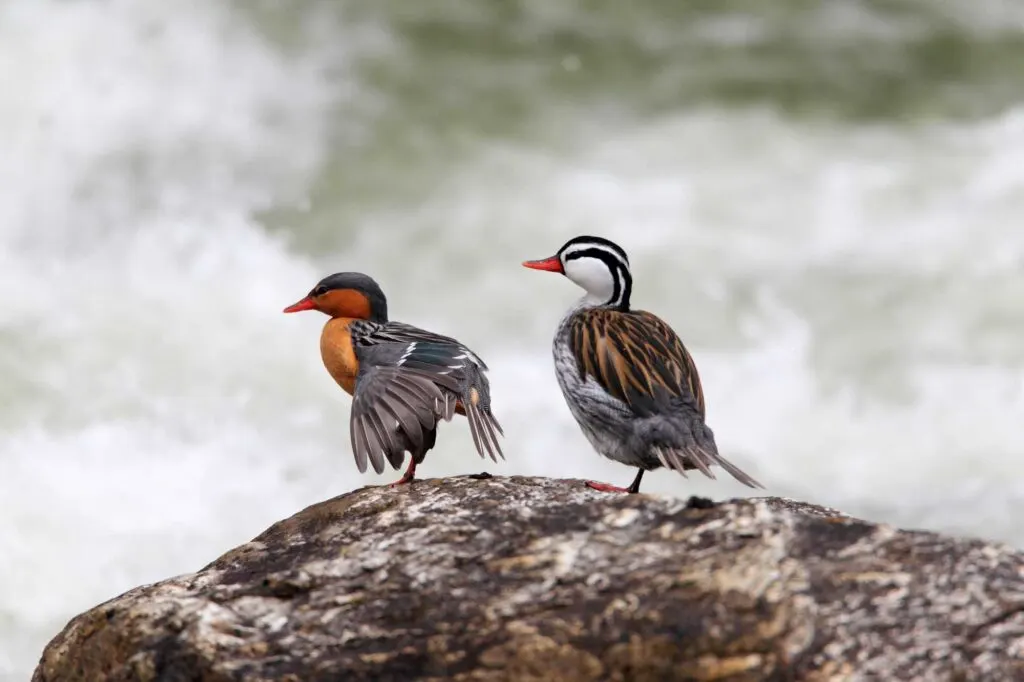
The torrent duck (Merganetta armata) is a perching duck species that loves fast mountain rivers in the South American Andes.
These species of duck are rarely found below 5,000 feet. These are reluctant fliers and powerful swimmers. Their long necks and elongated body is perfect for diving as they search for invertebrates.
The adults weigh 11.1-16.95 ounces, are 16.93-18.11 long, and average a 22-inch wingspan.
Drakes are identifiable by their red bill, white head with black stripes, striped pattern body, and green speculum.
The hens have an orange chest and throat, yellow-orange bill, and gray head and body. They whistle instead of quack.
19. Mandarin Duck
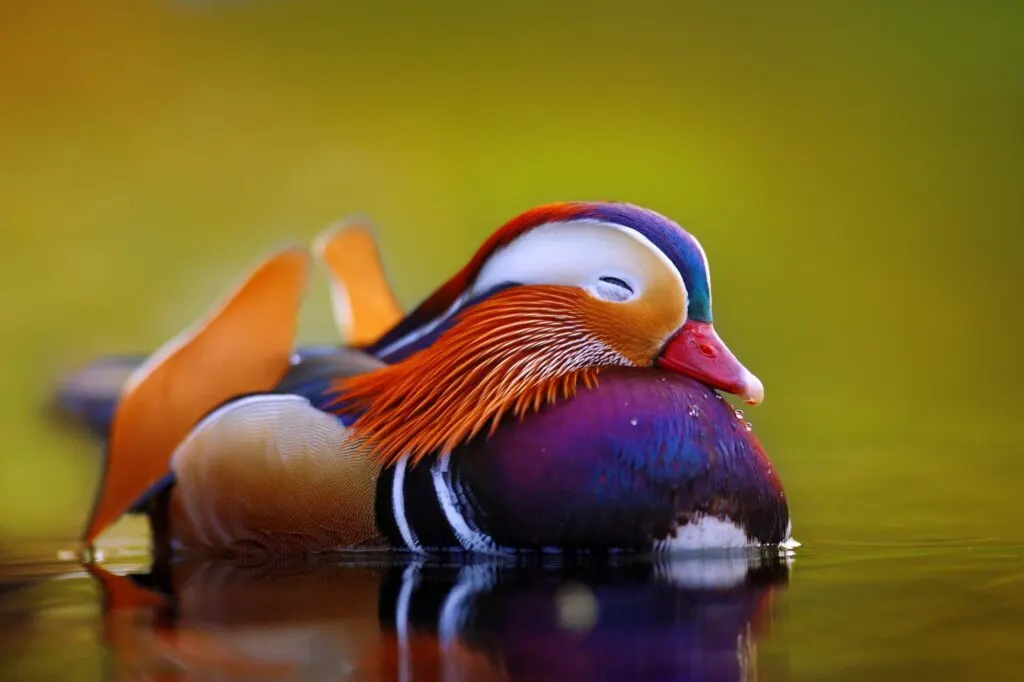
The Mandarin duck (Aix galericulata) is one of the most well-known perching duck species, sometimes mistaken for the wood duck.
These East Asian birds are famed for the drakes’ gorgeous coloring, swishing orange plumes on the cheeks with a contrasting crown, and light orange sides and “sails” with colorful bodies.
They are definitely one of the most colorful birds, right?
Interestingly, when the drakes molt, they will temporarily resemble the plainer females of grays and browns and a white eye stripe.
Mandarin ducks reach 16-19 inches in length and have a wingspan of 26-30 inches. The drakes can reach up to 1.4 lbs, and the hens up to 2.4 lbs.
Mandarin ducks are initially from East Asia but can now be found in parts of Europe and the United States due to human interference.
They prefer fresh water and areas with plenty of dense bushes and trees. They enjoy eating seeds, fruit, small fish, snails, and insects.
More Duck Types Worth Learning About
Lesser scaup
Green-winged teal
Hooded merganser
American black duck
Common merganser
Hey you! Did you enjoy reading about these duck types? Then share this article on your social media!
19 Different Types of Ducks
1. Red-Breasted Merganser
2. Ring-Necked Duck
3. Ruddy Duck
4. Harlequin Duck
5. Canvasback
6. Black Scoter
7. Long-Tailed Duck
8. Common Goldeneye
9. White-Winged Scoter
10. Northern Pintail
11. Blue Duck
12. Mallard
13. Northern Shoveler
14. Brazilian Teal Duck
15. American Wigeon
16. Cinnamon Teal
17. Wood Duck
18. Torrent Duck
19. Mandarin Duck
